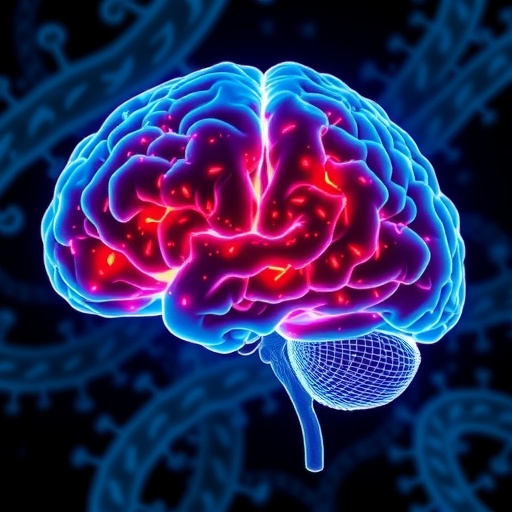In a groundbreaking study poised to reshape our understanding of post-COVID neuropsychiatric sequelae, researchers have unraveled compelling links between brain morphometry and gene expression in patients suffering from first-episode, treatment-naïve COVID-19 secondary depression (CSD). Published in the 2025 volume of BMC Psychiatry, this investigation elucidates profound cortical architectural changes measured via advanced neuroimaging techniques, unveiling how these alterations correspond tightly with distinct transcriptional patterns.
The study harnessed high-resolution structural magnetic resonance imaging (MRI) to meticulously examine the cortical morphometric inverse divergence (MIND) within 308 discrete brain regions. By leveraging multiple morphometric features integrated into comprehensive MIND networks, researchers contrasted data from 80 individuals newly diagnosed with CSD and 40 demographically matched healthy controls. The cohort’s design meticulously excluded confounding effects by focusing strictly on treatment-naïve patients experiencing their initial depressive episode following COVID-19 infection.
Statistical analyses employed generalized linear models factoring in critical covariates such as age, sex, and intracranial volume to isolate genuine neuroanatomical differences attributable to CSD. Strikingly, significant elevation of MIND values emerged prominently within the cingulate and supramarginal cortical regions—areas intrinsically linked to emotional regulation, memory consolidation, and language processing. These morphometric deviations bore a strong association with clinical measures of stress and cognitive impairment, independent of the frequency of SARS-CoV-2 infection episodes.
To unravel the molecular substrates underpinning these structural anomalies, the researchers implemented partial least squares (PLS) regression techniques to correlate regional MIND alterations with cortical gene expression profiles sourced from comprehensive spatial transcriptomic atlases. This innovative multi-pronged approach enabled them to identify gene sets whose expression patterns significantly tracked with morphometric disparities. Notably, one latent factor, referred to as PLS4, accounted for 17.7% of variance in MIND measures, with this factor’s positively weighted genes enriched in neurodevelopmental and metabolic pathways, whereas negatively weighted genes predominantly related to immune functions.
Delving deeper, the immune-associated genes (PLS4-) demonstrated preferential expression in microglia and astrocytes—key glial cell types instrumental in neuroinflammation and homeostatic maintenance. These genes localized to cortical layer I, which is implicated in complex cortical-cortical communications. Conversely, the neurodevelopmental and metabolic gene cohort (PLS4+) was markedly enriched in layer V, a principal output layer containing projection neurons critical for corticospinal and subcortical interactions. Such laminar specificity hints at nuanced pathophysiological mechanisms targeting discrete cortical strata.
Temporal developmental enrichment analyses revealed that these transcriptional signatures map onto disruptions occurring during both early brain maturation phases—including fetal and infant stages—and later adult neurodevelopmental periods. This bi-phasic developmental impact suggests a lasting vulnerability that spans across the lifespan, potentially underpinning CSD’s unique clinical phenotype. It also raises provocative questions regarding how SARS-CoV-2 infection may resonate with preexisting neurodevelopmental susceptibilities.
Crucially, this research challenges the simplistic notion that post-COVID depression is merely reactive or psycho-social in origin; rather, it advances a sophisticated multiscale framework wherein macrostructural brain remodeling and molecular dysregulation interplay in complex, cell-type-specific manners. These insights illuminate novel targets for therapeutic intervention, potentially guiding precision medicine approaches addressing both neuroinflammatory and neurodevelopmental components of CSD.
The identification of cingulate and supramarginal morphometric aberrations underscores the importance of focusing future studies on neural circuitry involved in emotion, memory, and language—domains frequently impaired in COVID-19 survivors. Moreover, the coupling of MRI-derived network measures with transcriptomic data exemplifies a cutting-edge paradigm, highlighting the synergy achievable by integrating imaging genomics into psychiatric neuroscience.
Importantly, these findings hold profound implications beyond COVID-19, illustrating how viral infections can precipitate enduring changes in brain architecture mediated by gene expression shifts within specific neural cell populations. The potential parallels with other neuropsychiatric disorders characterized by neuroinflammation and developmental disruptions warrant expansive explorations.
In summary, this landmark investigation expands our neuroscientific lexicon by linking unique cortical morphometric inverse divergence alterations in treatment-naïve, first-episode CSD patients to distinct transcriptional signatures. It provides compelling evidence for neurodevelopmental and immune-related mechanisms driving secondary depression after COVID-19, advocating for multidimensional approaches to understanding and treating this emerging public health challenge. As the global community grapples with the lingering neuropsychiatric aftermath of the pandemic, such research paves the way toward deciphering the intricate biological tapestries woven by viral infection and brain function.
Subject of Research: The study investigates cortical morphometric inverse divergence alterations and their correlation with cortical transcriptional signatures in first-episode, treatment-naïve COVID-19 secondary depression patients.
Article Title: Cortical morphometric inverse divergence alterations in first-episode, treatment-naïve COVID-19 secondary depression correlate with transcriptional signatures
Article References:
Li, C., Lin, Q. & Yang, L. Cortical morphometric inverse divergence alterations in first-episode, treatment-naïve COVID-19 secondary depression correlate with transcriptional signatures. BMC Psychiatry 25, 1110 (2025). https://doi.org/10.1186/s12888-025-07544-2
Image Credits: AI Generated
DOI: 10.1186/s12888-025-07544-2 (Published 20 November 2025)
Keywords: COVID-19 secondary depression, cortical morphometry, inverse divergence, transcriptional signatures, neurodevelopmental pathways, immune response, MRI, partial least squares regression, neuroinflammation, cortical layers, gene expression, brain networks




